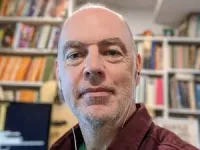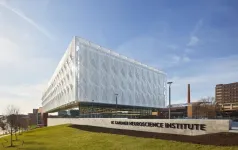(Press-News.org) Brigham Young University researcher Jeff Bednar is now a part-time ghost hunter. And while the business professor doesn’t have night vision cameras or ultrasensitive recording equipment, he’s found a bunch of ghosts — including several on his own campus.
The ghosts Bednar and University of Illinois colleague Jacob Brown are hunting sound similar to the ghosts you’ve heard of — they linger long after they’ve left this life and hover over their previous haunts — but they’re not necessarily the kind of ghosts that show up around Halloween.
They’re called organizational ghosts: admired former leaders that become embodied prototypes of the organization’s values and identity who continue to have outsized influence long after they’ve departed. Think Walt Disney, Coco Chanel or Steve Jobs. And it turns out these organizational ghosts tend to visit their old stomping grounds pretty regularly.
“Organizational ghosts can manifest themselves in a number of different ways,” said Bednar, an associate professor at BYU's Marriott School of Business. “It could be in the form of someone asking themself if a former leader would be proud of what they’re doing, or they might imagine how a former leader would approach a certain task before attempting it themselves.”
These ghosts transcend their physical presence, becoming immortalized within the organization and living on through associative learning, perpetuated practices and collective memory. The research, published recently in the Academy of Management Journal, found that organizational ghosts can serve to safeguard organizations from risky decisions, legitimize the actions of current leaders or devalue new leaders or other organizations.
Bednar himself regularly experienced “ghostly encounters” with an organizational ghost when he interned at Walmart headquarters in 2005. He noticed that the buildings he worked in had pictures and quotes of Walmart founder Sam Walton, who passed away in 1992, all over the walls, and employees constantly referenced Sam and told stories about him. Bednar was intrigued by the impact that Walton still had on the company over 10 years after his death.
“People in meetings were always talking about how they should try to do things the way Sam would have,” Bednar said. “It fascinated me, the impact and influence a leader could have on an organization even after they’re gone.”
Bednar and Brown’s research discovered that it isn’t just the founder of an organization who can become an organizational ghost. Any leader who makes a profound enough impact on showcasing and embodying the values of an organization can leave a lasting legacy that transcends their tenure.
At BYU, past leaders such as President Spencer W. Kimball have become profoundly influential organizational ghosts. In 1975, President Kimball delivered a seminal address about the future of BYU referred to as the “Second Century Address.” That address and the words of President Kimball continue to guide the university and its leaders in significant ways.
Hall of Fame football coach LaVell Edwards, who led BYU to a national championship in 1984 and is oft cited as a mentor by current coach Kalani Sitake, is another example of an organizational ghost at BYU.
Once the memory of these individuals is embedded in the minds and hearts of those who are a part of an organization, they often become preserved in physical artifacts and practices too, such as a newly planted tree, a parking space, an office or a room named after the organizational ghost. Or, in the case of LaVell Edwards, a football stadium. As a result, they can be “activated” in the minds of an organization's members when members imagine how they might approach a certain decision or recall the actions of a ghost and use that to influence their own actions.
But “ghost hunting” isn’t just for researchers like Bednar and Brown; everyone should be aware of the ghosts in their lives and the ways they continue to influence them.
"Which ghosts are most influential in your life? And how do they impact the way you think, feel, and behave?" Bednar said. “For me, one of the most important leadership lessons from this study was the importance of being aware of the historical dynamics that are always operating in the background in organizations. New leaders need to be especially conscious of those that have gone before them as they are making decisions that affect others in organizations.”
END
Just in time for Halloween: Researchers document the power of 'ghostly encounters' on organizations
2023-10-30
ELSE PRESS RELEASES FROM THIS DATE:
University of Cincinnati's UC Gardner Neuroscience Institute will continue to oversee U.S. NIH-funded stroke trials
2023-10-30
UC, UC Health mark 10 years as NIH StrokeNet National Coordinating Center, celebrate competitive renewal for next 5 years
Cincinnati, OH (Monday, Oct. 30, 2023) – The University of Cincinnati and UC Health have been renewed as the National Coordinating Center of the National Institutes of Health (NIH) StrokeNet, which is the primary infrastructure for multicenter trials of stroke funded by NIH and the pipeline for new potential treatments for adults and children with stroke and those at risk for stroke.
Created in 2013, NIH StrokeNet ...
ACC Middle East & Eastern Mediterranean 2023 Conference highlights evidence-based strategies, contemporary best practices for improving heart health
2023-10-30
The American College of Cardiology (ACC) and the Hellenic Society of Cardiology have teamed up to host the ACC Middle East & Eastern Mediterranean 2023 conference. The annual forum kicks off on November 3 – 5 in Athens, Greece, and puts the spotlight on the latest in cardiovascular prevention.
Global experts will converge for an innovative educational experience to discuss best practices for improving the heart health of patients with cardiovascular disease. Cardiovascular disease is the leading cause of death in the world. There are an estimated 11 million new cases of heart disease in Europe each year, while cardiovascular diseases are responsible for one-third of ...
Specific gut bacteria increase risk of severe malaria
2023-10-30
INDIANAPOLIS—Indiana University School of Medicine researchers have identified multiple species of bacteria that, when present in the gut, are linked to an increased risk of developing severe malaria in humans and mice. Their findings, recently published in Nature Communications, could lead to the development of new approaches targeting gut bacteria to prevent severe malaria and associated deaths.
Malaria is a life-threatening infectious disease caused by parasites transmitted through the bite of infected mosquitoes. According to the World Health Organization’s latest World Malaria Report, an estimated 619,000 people died from malaria ...
University of Oklahoma engineer awarded NIH grant to design algorithms for studying cancer initiation
2023-10-30
Marmar Moussa, Ph.D., an assistant professor of computer science professor at the University of Oklahoma, has secured a nearly $1 million award from the National Institutes of Health to advance her work in computational genomics.
The study, titled “Computational approaches to the mechanistic elucidation of the serrated pathway of human colon carcinogenesis,” aims to unravel the mechanisms driving the serrated pathway of human colon carcinogenesis using computational methods that help explain how colon cancer develops.
“This research is ...
Offset markets: New approach could help save tropical forests by restoring faith in carbon credits
2023-10-30
A new approach to valuing the carbon storage potential of natural habitats aims to help restore faith in offset schemes, by enabling investors to directly compare carbon credit pricing across a wide range of projects.
Current valuation methods for forest conservation projects have come under heavy scrutiny, leading to a crisis of confidence in carbon markets. This is hampering efforts to offset unavoidable carbon footprints, mitigate climate change, and scale up urgently needed investment in tropical forest conservation.
Measuring the value of carbon storage is not easy. Recent research revealed that as little as 6% of carbon credits ...
Window to avoid 1.5°C of warming will close before 2030 if emissions are not reduced
2023-10-30
**CORRECTION**
We have identified an error in this press release. The fifth paragraph of the release originally read:
The researchers warn that if carbon dioxide emissions remain at 2022 levels of about 40 billion gigatonnes per year, the carbon budget will be exhausted by around 2029, committing the world to warming of 1.5°C above preindustrial levels.
However, this should read:
The researchers warn that if carbon dioxide emissions remain at 2022 levels of about 40 gigatonnes per year, the carbon budget will be exhausted ...
Why all languages have words for ‘this’ and ‘that’
2023-10-30
Why all languages have words for ‘this’ and ‘that’
Languages around the world have words for ‘this’ and ‘that’ according to new research from an international team, led by the University of East Anglia.
Researchers studied more than 1,000 speakers of 29 different languages to see how they use demonstratives – words that show where something is in relation to a person talking such as ‘this cat’ or ‘that dog’.
It was previously thought that languages vary in the spatial distinctions they make - and that speakers of different languages may think in fundamentally different ...
Low-income countries could lose 30% of nutrients like protein and omega-3 from seafood due to climate change
2023-10-30
The nutrients available from seafood could drop by 30 per cent for low-income countries by the end of the century due to climate change, suggests new UBC research.
That’s in a high carbon emissions and low mitigation scenario, according to the study published today in Nature Climate Change. This could be reduced to a roughly 10 per cent decline if the world were to meet the Paris Agreement targets of limiting global warming to 1.5 to 2 degrees Celsius - which recent reports have shown we’re not on track to achieve.
“Low-income countries and the global south, ...
Dong engineering spatial wood carbon scaffolds with nanocellulose fillers for water deionization
2023-10-30
Pei Dong, Assistant Professor, Mechanical Engineering, received $250,000 from the U.S. Department of the Interior for the project: "Engineering Spatial Wood Carbon Scaffolds with Nanocellulose Fillers for Water Deionization." This funding began in Sept. 2023 and will end in Sept. 2025.
This project seeks to create an innovative and energy-efficient capacitive deionization process with the help of biomass-based advanced porous structures for water desalination and purification.
###
About George Mason University
George Mason University is Virginia's largest public research university. Located near Washington, D.C., Mason enrolls 38,000 students from 130 countries ...
Gilleaudeau conducting geochemical analysis of carboniferous carbonates & implications for ocean oxygenation
2023-10-30
Geoffrey Gilleaudeau, Assistant Professor, Atmospheric, Oceanic and Earth Sciences (AOES), received funding for the project: "Geochemical Analysis of Carboniferous Carbonates and Implications for Ocean Oxygenation."
He and his collaborators aim to generate a new composite carbon record through the lower Mississippian in the Williston Basin. They also aim to generate a new record that tests the hypothesis that carbon excursion was related to an expansion of global ocean anoxia, ...






